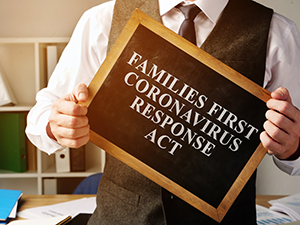Don’t pass up federal payroll tax credits for sick and family leave
 An employee is exposed to coronavirus and has to miss two weeks of work while self-quarantining. In another case, a parent has to take time off because her child’s daycare shuts down.
An employee is exposed to coronavirus and has to miss two weeks of work while self-quarantining. In another case, a parent has to take time off because her child’s daycare shuts down.
Many businesses are using their Paycheck Protection Program (PPP) loans to cover these situations along with other payroll expenses.
But in doing so, they are passing up the chance to benefit from another measure lawmakers passed to help companies: Families First Coronavirus Response Act (FFCRA) tax credits, which cover coronavirus-related employee leave through the end of the year.
Especially since lawmakers extended the time businesses can use PPP funds to 24 weeks, it makes sense for companies to evaluate all compensation paid to employees and whether any amount qualifies for FFCRA credits.
With the extended time to use PPP funds, many companies will find they can claim all eligible FFCRA credits and still have sufficient payroll, mortgage, and lease expenses to obtain maximum PPP loan forgiveness.
Additionally, companies that did not get a PPP loan can still qualify for an Employee Retention Credit (ERC), which is worth up to $5,000 per employee.
Providing FFCRA benefits and claiming credit
Under FFCRA, employers can receive credits through the end of the year for providing the following coronavirus-related benefits:
- Up to 80 hours of paid sick leave if the employee is quarantined and/or experiencing COVID-19 symptoms and seeking a medical diagnosis.
- Up to 80 hours of paid sick leave if an employee has to care for someone who is quarantined or if they have to look after a child whose school or care provider is unavailable due to COVID-19. (With many schools moving to virtual classes, businesses can use FFCRA credits for workers who need to take time off between now and the end of the year.)
Businesses can use FFCRA credits to cover 100 percent of the qualified sick leave wages (and allocable qualified health plan expenses and the eligible employer’s share of Medicare tax on the qualified sick leave wages).
Additionally, workers employed for at least a month are eligible for up to an additional 10 weeks of family leave wages at two-thirds of their regular pay rate if they have to miss work to care for a child due to the circumstances mentioned above.
Family leave wages are limited to $200 per day and $10,000 for the calendar year, per employee. Similar to paid sick leave, employers can also receive a credit for qualified health plan expenses and the eligible employer’s share of Medicare tax on the family leave wages.
Note: FFCRA requirements generally apply to businesses with between 50 and 500 employees. Smaller companies may qualify for an exemption.
Claiming FFCRA credits
Most businesses will claim FFCRA credits on their quarterly return (Form 941). If you failed to claim these credits in your initial second-quarter filing, which was due on July 31, you can still amend your filing.
Due to all the coronavirus tax-related changes, the IRS is playing catch up, meaning that you may experience a longer than usual delay in processing amended returns and payment of related tax credits.
Businesses able to claim FFCRA credits in the second half of 2020 can either reduce the amount of payroll taxes by the amount of the anticipated credit or request a refund on their quarterly return.
If a business is entitled to a credit of more than required payroll tax deposits, it can file a Form 7200 — “Advance Payment of Employer Credits Due to COVID-19” – before quarterly filings are due.
Businesses can also file a Form 7200 to receive credits quicker – and companies are allowed to file several Form 7200s per quarter if needed.
Employer Retention Credit
Businesses and nonprofits that did not receive a PPP loan can still receive an Employer Retention Credit of up to $5,000 per employee if they either had to suspend operations due to the pandemic or suffered a significant decline in gross revenue.
Claiming this credit is done the same way as you would for FFCRA credits: including the credit on your quarterly tax filing; reducing the amount of payroll taxes by the expected credit; or filing a Form 7200 if the credit amount exceeds your payroll taxes or if you want to receive the credits quicker.
Bottom line
Calculating credits owed under FFCRA or ERC can be complicated, and we suggest contacting your accountant to ensure you follow all the guidelines.
Boyer & Ritter can help you navigate through compliance requirements and provide a reliable and trusted source of information for your lender and the government.
To learn more about engaging us for PPP Loan Forgiveness Support Services, please contact us HERE. If you have questions about the ERC program, please contact us HERE.
Benjamin R. Bostic, CPA, is a director at Boyer & Ritter with experience providing tax and accounting services for closely-held businesses, individuals, not-for-profit organizations. Reach Ben at 717-264-7456 or bbostic@cpabr.com



